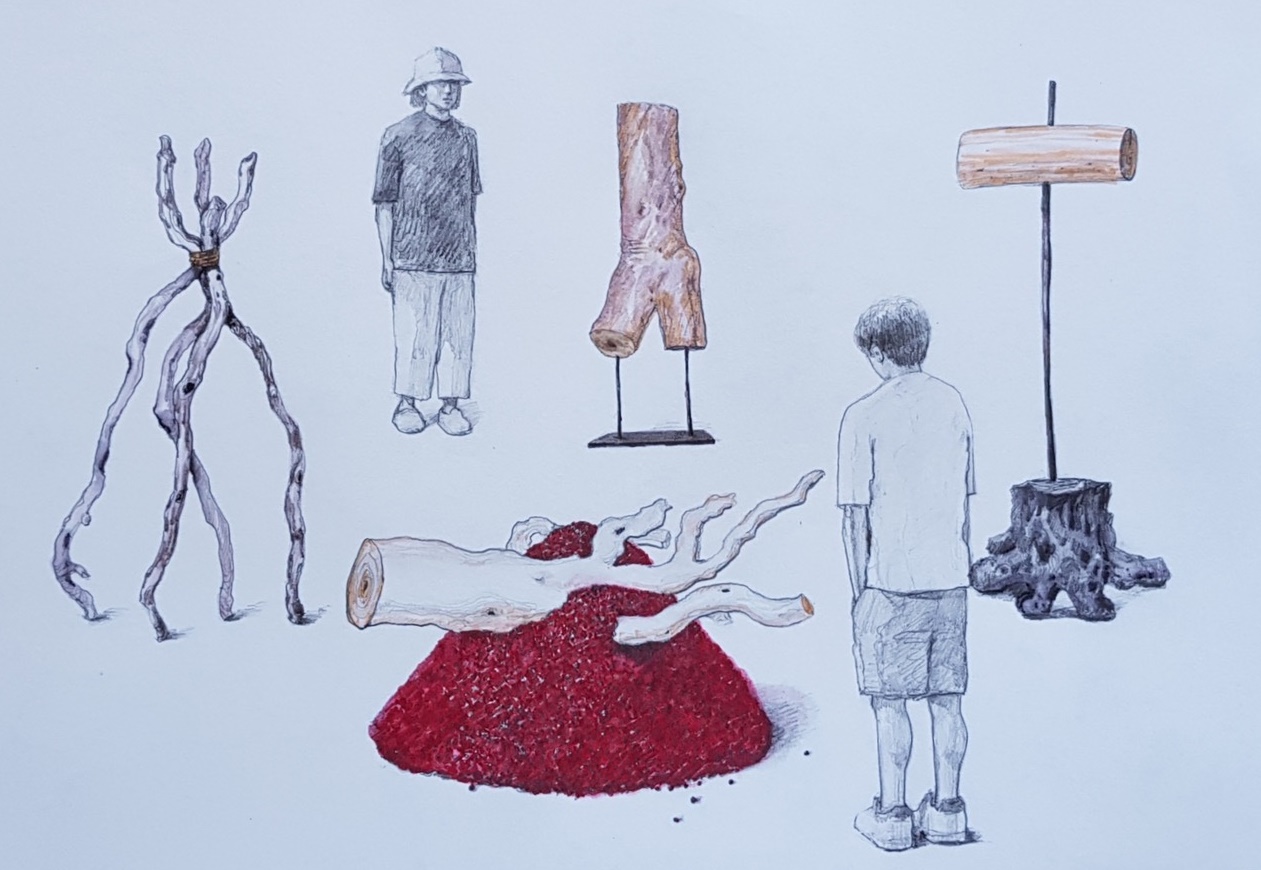[ 2021 ] 조세진 (한국) Cho Sejin (Korea)
페이지 정보
본문
조세진 (한국)
Cho Sejin (Korea)
<네개의 문 Four Doors>

부처가 아직 사카족의 왕자 싯다르타였을 때 4가지 광경을 보고 궁을 떠나 고행의 길을 시작했다고 한다. 첫 번째 광경에는 노인이, 두 번째는 병자, 세 번째는 시체, 그리고 네 번째는 고행자의 모습이 있었다고 한다. 나는 이 네 가지 광경을 서로 다른 형태와 질감, 색감을 가진 나무둥치들과 붉은 팥을 이용해 생과 사의 굴레를 살아가는 모든 존재에 대해 표현해보고자 한다.
네 개의 문이라는 제목은 마치 닫힌 문 뒤에 무엇이 있는지 알 수 없는 것과 같이 삶의 모든 순간이 예측할 수 없이 다가옴에서 착안했다. 우리 삶의 시간에는 언제 어디서 올지는 모르지만 살아있는 존재에게 반드시 일어나는 일련의 장면들이기에 문이라고 표현했다. 네 가지 조형물들을 각각, 또 한꺼번에 바라보며 삶을 다른 각도에서 관조하는 경험을 제시하고자 한다.
나는 살아있음을 작업으로 표현하는데 천착해 왔다. 살아있는 것은 지속적으로 변하고 필연적으로 죽음을 맞이한다. 나무는 삶과 죽음의 중간자적 존재다. 가지 하나를 다시 심어도 그 가지에서 뿌리를 내고 다시 자라나고, 큰 둥치를 베어도 뿌리에서 다시 새 이파리를 낸다. 나무의 껍질과 껍질을 벗겨낸 속살의 결과 옹이는 참으로 아름답다. 그 아름다움은 나무의 삶이 새겨진 증거이며 시간을 살아낸 행위의 기록이다. 부처는 살아있음은 고통의 바다라고 했다. 고통의 바다에서 파도가 치듯 희로애락이 끝없이 밀려오는 와중에 모든 존재는 자신의 삶의 무게를 온전히 스스로 감당해야 한다. 나는 이 생각을 하면 살아있는 모든 존재와 내가 연결되어 있음을 매번 다시 깨닫는다.
네 가지 형상은 각각 고행자, 병자, 노인, 죽음을 대변한다. 어떤 형상을 무엇으로 볼지는 보는 이의 관점에 따라 달라질 수 있는 여지를 남겨두었다. 나는 네 가지 형상 모두를 존재의 변주로 여긴다. 병자이면서 고행자, 노인이면서 또한 고행자, 죽은 고행자, 또한 고행자이면서 그 모두일 수 있다.
네 가지 조형은 껍질을 벗긴 희고 매끈한 둥치를 쌓아둔 팥 둔덕 위에 올린 것, 벌레 먹은 가지 다발, 뿌리와 껍질을 벗긴 직선 형태의 가지를 철제봉으로 연결한 것, 굵고 옹이가 많은 가지를 거꾸로 세워 좌대에 고정한 것이다.
팥은 상징적인 곡물이다. 붉은색이 태양, 불, 피 같은 생명을 연상하게 하기에 주술적인 의미도 가진다. 또한 씨앗이기에 팥알 하나하나가 무수히 많은 생명의 가능성이다. 팥 위에 놓인 흰 둥치는 피와 살의 상징이며 시각적 대비를 준다.
When Buddha was still a prince Siddharta, he decided to leave the palace, starting his path of penance, after watching four scenes: an old man, a sick person, a corpus, and an ascetic. I would like to describe the four scenes – all the beings living in the cycle of life and death – with tree trunks with different forms, textures, and colors and red bean.
I chose the title, Four Doors, to symbolize that, as we cannot see what object there is behind door, every moment in life comes to us without notice. While we don't know when and where we will confront those four scenes, we can never avoid the scenes. Thus, I expressed them as doors. I want to suggest to spectators that they watch four sculptures one by one, and together, thinking our life in different angles.
I have focused on expressing life with my works. Anything which lives continuously changes, inevitably encountering death. Tree is an existence between life and death. Even if we plant a branch of it, it takes root and grows as a tree. Even if we cut the trunk, its root sends out new leaves. Tree bark and knot are really beautiful. They are the evidence of the life of tree, and the record of its life. Buddha said life of sea of agony. As man faces incessant flows of happiness, anger, sadness, and joy in the sea of agony, he or she should bear the weight of life alone. Thinking of such things, I recognize that I am connected to all the beings in the world.
The four features represent disease, aging, death, and agony. I leave spectators of my work interpret four features in their own ways. I consider all the features as variations of life. We can be any of sick persons, ascetics, or old men.
Four sculptures are as follows: the white and sleek peeled trunk on the red bean heap; a bundle of worm-eaten branches; root and straight branch linked by an iron pole; a thick and knotted branch put on the pedestal.
Red bean is a symbolic grain. Red color reminds us of the sun, fire, or blood, having magic connotation in it. As bean is seed, it has potential of life. The white trunk put on the heap of red bean is the symbol of blood and flesh, and gives visual contrast with red bean.
- 이전글치로 아모스 페레로 (이탈리아) Ciro Amos Ferrero (Italy) 21.08.25
- 다음글지연신 (한국) Chee Yeonshin (Korea) 21.08.25
댓글목록
등록된 댓글이 없습니다.


